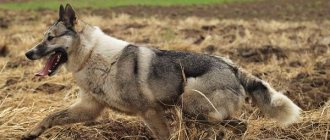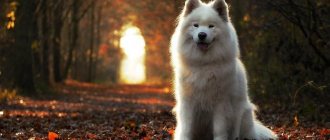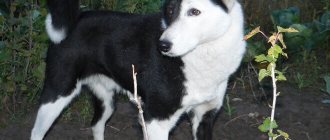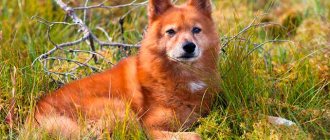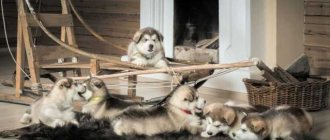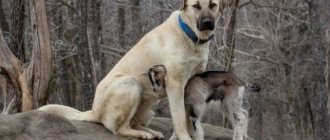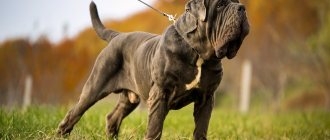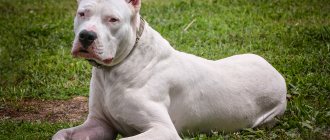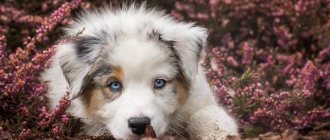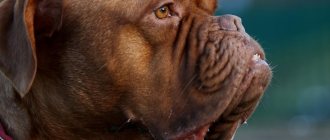| Origin | Russia |
| Usage | universal hunting dog, companion |
| Color | plain white, two-tone, reddish-brown of any shades, grey, fawn |
| Dimensions | 51-62 cm, 19-22 kg |
| Lifespan | 12 years |
The West Siberian Laika is the pride of Russian cynology. Only in harsh Siberia could such a hardy, reckless, sensible, people-loving hunting dog be born. It is not surprising that the breed is the most common among huskies.
History of the breed
The West Siberian Laika is a descendant of aboriginal hunting dogs that have lived beyond the Ural Range since time immemorial.
It is worth noting that until the beginning of the 20th century. In the taiga villages there lived many breeds of huskies, each of which had its own distinctive features and loyal fans among local hunters. There was no talk of division into breeds and intrabreed types at that time, so animals freely crossed with each other, giving humans the right to select the most successful “specimens.” Nevertheless, even in such conditions, the stratification into leaders and outsiders was quite natural. Therefore, when in 1939 there was talk of standardizing huskies, experts immediately turned their attention to the Mansi (Vogul) and Khanty (Ostyak) offspring, which had established themselves as excellent hunters of taiga animals. Also in 1939, a meeting of Soviet cynologists was held, at which five main breed types of animals were approved, which included the wards of the Khanty and Mansiysk fishermen. The purposeful breeding of the ancestors of West Siberian huskies began in the 40s of the 20th century. due to state necessity. The country waging war needed money, which could be obtained, among other things, from the sale of furs and meat. Well, it was up to Siberian hunters and their four-legged assistants to get this valuable product. According to the official version, the mission to popularize the breed was entrusted to the Krasnaya Zvezda nursery, although in fact, breeding and a kind of PR of animals were also carried out in breeding nurseries of the Novosibirsk, Sverdlovsk and Perm regions.
In 1947, the Soviet cynologist E.I. Shereshevsky proposed classifying domestic huskies according to the geographical principle, according to which the Khanty and Mansi offspring were united into a common, West Siberian group. The proposal was not immediately accepted for consideration, but in 1952 the section of northern hunting dogs was replenished with three new breeds - the West Siberian, Karelian-Finnish and Russian-European Laika. A sharp jump in the popularity of the ZSL occurred in the 60-70s, after which foreign breeders and cynological associations became interested in the animals. And in 1980, the breed was finally recognized by the FCI, which opened the way for it to international exhibitions and competitions.
Important point. It is not entirely correct to consider the West Siberian Laika as a pure descendant of Mansi and Khanty hunting dogs. The breed did not develop in isolation, so mixing the blood of other offspring into its phenotype was common. Experts are confident that today's WSLs have inherited part of the gene pool of the Udmurt, Ural, Nenets, Evenki and Zyryansky (Komi) Laikas, as well as some breed traits of German Shepherds.
Origin
Unfortunately, the exact origin of the breed is unknown. According to one version, the ancestors of the first WSLs were taiga wolves of the Khanty-Mansi Autonomous Okrug, which, as a result of selective selection and crossing, acquired loyalty to humans without losing their hunting qualities. Other sources talk about aboriginal Laikas in Western Siberia. The breed of West Siberian huskies owes its breeding directly to Joseph Vissarionovich Stalin, who issued the corresponding order. The first breed standard was approved in 1949. Still in force today with a single amendment from 1952. In 1980, the West Siberian Laika breed was officially recognized by international cynological organizations.
Breed standard West Siberian Laika
The West Siberian Laika is a dog of a strong, albeit somewhat dry build, hardy and incredibly fast when it comes to chasing prey. By the way, this is one of those breeds whose representatives are affected by sexual dimorphism, so ZSL males are much larger than females. You can distinguish a purebred West Siberian Laika from a pack of mestizos by body proportions. In particular, the length of the body of purebred individuals significantly exceeds their height at the withers. In proportional terms, it looks like 103-107/100 in males and 104-108/100 in females. If you compare the height of the animal’s withers and rump, then the first will be a centimeter or two larger (in female dogs the discrepancy is smaller or absent altogether). Special requirements are also imposed on the front legs of the husky: their length must be equal to ½ the height of the pet at the withers.
Although the West Siberian Laika has been a factory breed for almost 80 years, puppies periodically appear in its litters, reminiscent in appearance of their Vogul-Ostyak ancestors. In this regard, cynologists distinguish two main intrabreed types of ZSL - Khanty and Mansi. Representatives of the first variety are distinguished by their comparative squatness, have a wide head in the shape of an equilateral triangle and a rich dog’s body, giving the dog’s silhouette additional volume. Mansi Laikas are usually taller and poorer dressed, their skulls are narrower, and their eyes are more round and expressive.
Head
The head of the West Siberian Laika is dry, elongated, triangular in shape. The skull is narrow (a feature most pronounced in females), with a flat or slightly rounded forehead. In general, the profile of the animal is not particularly prominent: the eyebrows of the ZSL are not too prominent, the line of the stop is smoothed. The dog's muzzle is wedge-shaped, equal in length to the skull.
Jaws and teeth
The purebred West Siberian Laika has a full set (42) of strong teeth and powerful jaws with a scissor bite.
Nose
The earlobe is of normal size, painted black. At the same time, for individuals with white fur, a lighter, brownish shade of the lobe is typical.
Eyes
The dog's oblong, dark brown eyes are slightly slanted. Another distinctive feature is that the eyeballs of the ZSL are set deeper than, for example, those of other varieties of huskies.
Ears
The ears of the West Siberian Laika are erect and have a regular triangular shape.
Neck
The dog's neck is elongated, well muscled, and dry.
Frame
The animal's sculpted withers smoothly transition into a straight, wide back, ending in a massive and somewhat inclined croup. The chest of the ZSL is deep and of good width. The abdomen is moderately tucked.
Limbs
The front legs of the West Siberian husky are even, spaced at a fairly distant distance from each other (wide set). The shoulder blades are long, strongly laid back, the elbows are pressed to the body, with developed joints that “look” back. The dog's hind legs are muscular, with long, strong thighs, strong knees and almost vertical metatarsals. The paws are oval in shape, with the hind legs being smaller in size than the front ones. The fingers of the ZSL are arched and collected, but the middle finger stands out somewhat from the general row due to its greater length.
Tail
Rolled into a “steering wheel” and thrown on its side or in the lumbar region. When unrolled, the tail hangs down to the hocks.
Wool
The coat of the West Siberian Laika is formed by moderately hard outer hair and a voluminous, insulating layer of undercoat. In the shoulder area the dog's fur grows thicker, resulting in a rich collar framing the dog's neck. The fur on the front of all four legs is relatively short, with soft “pants” on the hips. Small tufts of bristly hair also grow between the husky's toes, performing a protective function.
Colors
The animal's fur is most often colored in red, piebald, gray, red-brown and white tones. The following combinations are also acceptable: white with brown, gray, red, fawn spots, zone-piebald, zone-red.
Disqualifying defects of the breed
- Congenital malocclusions.
- Aggression or excessive indecisiveness.
- Jaw distortion.
- Behavioral and physical deviations that are too obvious.
- Absence of four or more teeth/presence of additional incisors.
- Drop or semi-erect ears.
- A cataract (clouding of the cornea), as well as the color of the iris interspersed with a shade that is unacceptable by the standard.
- The tail is too short or has an atypical shape (saber-shaped, straight, etc.).
- Short/not long enough coat.
- Albinism. Non-standard coat colors: blue, brindle, chocolate.
Distinctive features
According to the standard, representatives of the West Siberian Laika must have the following breed characteristics:
- Size and Weight: Cables can grow up to 63 cm and weight can reach 22 kg. Smaller females – height up to 60 cm, weight up to 20 kg.
- Head: dry, sharp wedge shaped. Length is greater than width.
- Muzzle: Elongated. Expands starting from the fangs.
- Eyes: small. The color is exclusively brown.
- Ears: erect, triangular. The lobe is underdeveloped.
- Nose: black (brown nose is allowed in light-colored dogs).
- Cheekbones: underdeveloped.
- Neck: dry, with well-developed muscles, set at an angle of up to 55˚.
- Paws: front straight, long, set wide. The hindquarters are muscular and set parallel.
- Body: strong, muscular. The chest is deep, wide and long. The back is straight.
- Tail: covered with a thick layer of wool, curled into a tight ring thrown over the back.
- Coat: hard, with a thick and soft undercoat. Evenly distributed.
- Color: White, grey, red (sometimes with white spots), fawn and black.
Character of the West Siberian Laika
Laikas are like that... huskies and West Siberian are no exception. Therefore, before acquiring such an active pet, it is better to ask yourself the question: do I have enough energy and patience so as not to turn the dog’s and my own existence into an eternal struggle for interests? The “talkativeness” of the breed should not be discounted. Barking for an SSL is not just another attempt to get on your nerves, but a means of communication, so don’t expect to hear a loud “Woof!” pet only for hunting.
Their agility, innate playfulness and curiosity make West Siberian Laikas wonderful hunters and athletes, but they are not the most outstanding companions. Accordingly, if seasonal trips for trophies do not interest you as such, there is no point in getting involved with the breed. Chasing an animal for a husky is perhaps the main purpose of its existence, and depriving an animal of this joy is simply cruel.
For the West Siberian Laika, any person is either a friend or a future buddy, which, of course, affects the dog’s security and watchdog qualities. On the one hand, the animal is not deprived of them and, with proper training, is capable of driving away unwanted persons from its home. On the other hand, too ardent defense of the owner’s property indicates the instability of the four-legged comrade’s psyche, which is unacceptable in principle for a hunting breed.
West Siberian huskies respect the laws of the pack and never measure their strength with those who are weaker, so it is quite reasonable to leave them to look after children, to whom the dogs are friendly and patronizing. It is believed that APs are inclined to demonstrate independence and should not be limited in this. Nevertheless, representatives of this breed will not fight with a person for the right to be a leader for any price. The owner of a husky is a friend and mentor, with whom she sees no point in competing, because working in pairs is much more interesting and correct.
The hunting instincts of representatives of the West Siberian Laika breed make themselves felt not only in the wild. In particular, SAWs are very intolerant of any animals they are not personally acquainted with. Experienced dog lovers also know that keeping several ZSL males in one territory is an amateur’s pleasure with a very consistent character, since the dogs almost never stop competing with each other and finding out “who’s boss.”
Key facts
The West Siberian Laika is dependent on human attention, so it does not feel well alone. However, on walks she is very independent. This dog needs constant supervision, otherwise it may, in pursuit of a passing car or something else, run far enough away from you and get lost.
The description of the West Siberian Laika says that they live quite peacefully with other pets, but this kindness does not affect street animals. All stray cats, pigeons or strange dogs will certainly be barked at and driven off the road.
The West Siberian Laika is by no means a gambling dog. Unlike her relatives in the section, her hunting nature does not prevent her from being more calm and balanced, and the characteristics of the West Siberian Laika breed are replete with positive reviews.
A dog left alone for the whole day in a closed apartment will inevitably begin to destroy it, and given its size and sharp mind, this process will not take it much time. If you disappear all day at work, be prepared for at least gutted pillows and overturned flower pots waiting for you at home.
Although the husky can be quite aggressive towards other animals, this does not apply to humans, so it will not make a security guard or night watchman. She will always be glad to have any guests and will always let them into the house.
Dogs of this breed are used in any type of hunting from catching birds to large animals like wild boar or bear, not to mention fur-bearing animals or other small game.
The lifespan of the West Siberian Laika directly depends on the conditions of its keeping. If its working qualities are not realized, the dog may die early.
Education and training
The West Siberian Laika is not a circus dog, so do not waste time with it learning acrobatic tricks, which are essentially of no use to a hunting breed. It is also important to take into account the psychological characteristics of SSL: slight stubbornness, self-will, loss of interest in learning - all this will certainly occur, although not on a very outstanding scale. It is advisable to start raising and training a puppy from the age of 3 months using standard methods, that is, try not to overtire the baby, try to introduce him to new behavior patterns through play, etc. It is good if it is possible to take your pet to group classes. West Siberian Laikas have very strong gregarious and competitive instincts, which is why they always work more actively in a team. By the way, you can practice hunting skills with a dog only after it has mastered the basic obedience commands (preferably passing OKD).
Pay special attention to prohibitive commands. Excessive independence inherent in the breed should be easily corrected. If the dog does not respond to the ban, this is fraught with big trouble. In particular, it costs nothing for an SSL to run away during a walk, carried away by the pursuit of a gaping cat. Don’t go to the other extreme and don’t train your pet. The West Siberian Laika is not a terry intellectual and a wearer of slippers, but a strong, merciless hunter, capable of mastering the basic principles of etiquette exactly as much as is necessary in order to get along with a person and not create unnecessary problems for him.
Mating
Puberty, along with the first estrus, occurs in West Siberian husky bitches before one year. But this is a very early age for mating. You should not breed a dog of any gender before 18 months of age.
For good and healthy offspring, it is necessary to carefully choose the cable for mating (it is advisable that the partner has documents).
Before estrus, the female usually begins to behave restlessly, or, on the contrary, she will be too calm. Also, the pet will often ask to go outside. Another two signs of imminent estrus are enlarged genitals and spotting. But before mating, you need to wait until clear discharge appears.
- First, the dogs need to have a first date, which will take about 15 minutes . The best time is morning. Pets should not be fed before mating. The entire process must be under the control of both owners.
- Sexual intercourse of huskies can last up to 45 minutes. But the next morning you will need to repeat the procedure.
- It happens that the bitch does not allow the cable to come near her. This means that she needs more time to get to know each other. And it happens that she simply doesn’t like her partner. And then you won’t be able to breed dogs.
- If the husky mating was successful, then after about three weeks you will notice a rounded tummy on the pet. The pregnancy itself can last up to 2.5 months . And in the first month there should be no changes in the dog’s life. After all, pregnancy is not a disease. When you enter the second month of pregnancy, you can increase your diet to three meals.
- It is better to arrange an enclosure in one of the rooms, and place the expectant mother there about a week before the birth. The main thing is that the room is warm and dry. It is necessary to place a box with a diaper in the room. And during pushing, make sure that the pet is in the bed. Because during the first birth, the dog may get scared and start looking for a hiding place.
After the first puppy appears, you cannot touch the bitch. After giving birth, it is necessary to wipe the pet's genitals. After feeding the puppies, she can be taken outside for a short time for natural reasons.
Hunting with the West Siberian Laika
In terms of hunting, the West Siberian Laika is a real all-rounder, capable of getting any game for its adored owner, from squirrels to bears. The dog’s upper and lower senses, which are equally well developed in representatives of this breed, innate viscosity (perseverance in pursuing a goal and searching for a scent) and a ringing bark help the dog not to lose the status of a super hunter. Another feature of the breed is the ability to work on the old track, which is considered aerobatics and is not given to all representatives of the section.
If you plan to raise your pet to be a full-fledged earner, and not a useless “holder of a hunting diploma,” it is better to train the animal not on training grounds, but in natural conditions, where the animal is real, and not stunned by the endless barking of four-legged “students,” and the danger is real. By the way, it is absolutely not necessary to make a West Siberian husky “a master of all trades.” No matter how remarkably smart a dog is, it is not able to catch a sable for you today, a wild boar tomorrow, and a bear a week later. Of course, there are exceptions, but this is an innate gift that is found only in a select few.
The degree of development of hunting instincts in West Siberian huskies depends on how often the dog finds itself in the wild. If you are used to taking your pet into the forest a couple of times a season, then don’t expect him to demonstrate any superpowers. For a proper husky, going hunting should not be a holiday, but a natural change of location, where the animal must feel as confident as in its own enclosure. By the way, it’s better not to delay training. At 5-6 months, the puppy is already ready to periodically walk with the owner in the forest, practicing walking nearby and getting used to the surrounding smells and sounds. 10-month-old adolescents can begin to be introduced to the beast. It’s great if an adult hunting dog already lives in the house. In this case, the puppy will have someone to learn from. And keep in mind that if by the age of 2 the West Siberian Laika does not begin to work with game, then it will be pointless to work with it.
Application
The standard description of the breed characterizes REL exclusively as a hunting dog for wide use. Dogs calmly and purposefully chase prey for a long time, regardless of weather conditions. A developed reaction helps huskies coordinate movements alone and as part of a pack. Dogs hunt down prey using barking and cunning.
REL aggression is shown only towards the object of hunting and never towards people.
However, dogs are wary of strangers, which makes the Russian-European, East Siberian and West Siberian Laika excellent guards. When in danger, dogs raise their voices, but do not openly attack. If desired, increased anger and wariness can be developed in an animal, but only through the authority of the owner, and not through physical punishment. By accepting the training well, REL is able to learn how to apprehend offenders.
Maintenance and care
West Siberian huskies easily tolerate Russian frosts and are quite adapted to extreme weather conditions, so the best place of residence for a working dog would be an enclosure in the courtyard of a private house. In addition, for a comfortable existence of a pet, a pet requires a lot of free space, so the option of moving a pet into an apartment is regarded as the worst possible. It is also important to understand that, unlike their Russian-Finnish counterparts, West Siberian Laikas have difficulty getting used to life in a metropolis, or indeed any city. These restless “Siberians” prefer the countryside or at least the urban outskirts.
List of things needed to keep a West Siberian Laika:
- insulated booth with bedding;
- bowls for food and drink;
- toys;
- leash for walking (from 2 m) and collar;
- muzzle;
- collar tracker with GPS (for hunting enthusiasts).
You won’t be able to place a West Siberian husky in a booth or enclosure and relax, since you will have to change the animal’s straw bedding weekly and remove its waste products at least once a day. In addition, once a month it is recommended to completely disinfect the enclosure.
Hygiene
The West Siberian Laika is an unpretentious working dog and there is no point in traveling with it to grooming salons. Yes, during the molting period (autumn-spring), the ZSL’s fur will have to be combed with a sparse comb, sometimes using a furminator, but otherwise not much time is spent on caring for and creating the image of the pet. Laikas are rarely washed: mainly before exhibitions or when the animal is thoroughly dirty. Moreover, in the summer, occasional swimming in open waters will be enough.
Working and well-walked dogs do not need to have their nails trimmed at all. For individuals that are not particularly active, the plate is trimmed once a month with a nail clipper for large breeds. At the same time, it is better to examine the eyes and ears of the inhabitants of enclosures daily, so as not to miss or cause inflammation. One of the main working “tools” of the West Siberian Laika is its paws; accordingly, after hunting and walking, they should be given increased attention. Minor cuts, scratches, and other injuries should be treated immediately with veterinary ointments or creams. A good help would be vegetable oils, which are used to lubricate the paw pads to prevent the appearance of cracks and peeling on them.
Walking and training
The West Siberian Laika, which does not fully realize its energy potential, becomes depressed, goes bald and often gains weight. Therefore, in order for the pet to be vigorous, healthy and live the entire life allotted to it, it is better to load it to the maximum. It is necessary to go out with the dog to get some air at least twice, and preferably three times a day, and the duration of the walk should be at least an hour. Be sure to include in these 60 minutes not only standard runs on a leash, but also elements of training, as well as active games. In order not to misbehave at home, the West Siberian Laika must give all its best outdoors, so ordinary festivities are not enough here.
When taking your ward out to a park, square or forest belt, do not lose vigilance. ZSL males are captivating natures and instantly disappear from sight if potential prey looms on the horizon. The best prevention of this behavior is a standard leash, which allows you to control the movement of the animal. In general, once on the street, West Siberian huskies demonstrate eerie independence and pay almost no attention to their owner, preferring to mind their own business. Sometimes it is difficult to “get through” to a dog, but it is necessary to do this, since it is the overly self-confident and uncontrollable individuals that most often disappear during the hunt.
Feeding
West Siberian huskies prefer animal protein to replenish the energy spent on hunting and training. Any lean variety of meat is suitable here, from lamb to beef, and it is better if it is substandard - sinewy trimmings, weathered pieces, etc. The meat is given raw or slightly scalded, but in no case boiled. Once a week, offal and fish (preferably the cod family) should appear in the dog’s bowl, and the size of the usual portion will have to be increased by a third.
Low-fat sour milk, porridge from coarse cereals, thermally processed seasonal vegetables also diversify the ZSL menu. You should not neglect vitamin supplements, since few people succeed in balancing their diet with the help of exclusively natural products. Feeding the West Siberian husky “drying” is regarded as a completely acceptable option, but in this case the desire to save money will have to be abandoned. Low-quality feed will not only not satiate the animal, but will also ruin its digestive and urinary systems.
Important: West Siberian huskies are usually not fed before a hunt.
Nutrition
A ready-made diet (dry food) is perfect for the West Siberian Laika. She should eat at least 800 grams of this product per day. Don't skimp on it! Buy only premium food. How to distinguish good dry food from bad? Answer: by composition. In a quality product, the main ingredient should be meat.
If your pet is fed dry food, periodically feed it with offal, fortified foods, for example, berries or vegetables, bone cartilage, fermented milk, etc. What definitely should not be included in its menu:
- Fatty foods cooked in oil.
- Pastries, cream cakes.
- Expired products.
- Fat cottage cheese.
- Stewed lamb or pork.
- Fatty fish with bones.
- Chocolate and marmalade.
Remember, your husky should eat plenty of vitamins at any time of the year, so never deprive her of the pleasure of eating a banana in winter or a fresh tomato in summer.
Health of the West Siberian Laika
Centuries of natural selection and the harsh climate of the West Siberian Plain have polished the health of animals to a standard state. As a result: West Siberian huskies have excellent immunity and virtually no genetic diseases. The main enemy of the breed is forced physical inactivity, which provokes a lot of ailments, ranging from obesity to joint diseases. Hunting trips also pose a danger to the health of dogs. Carried away by the pursuit of an animal, huskies can be injured by flying into trees, although they recover from such “accidents” surprisingly quickly. Animals are often bitten by snakes, ticks and small predators, so timely vaccination against rabies and treatment against ectoparasites will not be superfluous. In addition, FAWs can become infected with worms from caught and eaten game, so do not forget to replenish your veterinary medicine cabinet with anthelmintic medications.
How to choose a puppy
- West Siberian Laika males are more independent, prone to running away, and also often sort things out in the pack. At the same time, the “boys” have distinct breed characteristics and look very colorful. ZSL “girls” are less impressive in appearance, but they are more flexible and easier to learn. The only disadvantage of females is regular estrus, which interferes with hunting.
- When choosing a puppy for hunting, take an interest in the working achievements of its parents, or better yet, look at one of them in action.
- Give preference to apparently healthy, moderately well-fed babies who react to your arrival with curiosity and loud barking.
- Don’t put too much faith in the old, “old-fashioned” methods of selecting the best puppy (testing on a log, squeezing the husky’s belly with your fingers, selecting by the color of the paw pads), which are so popular among inveterate dog lovers. In 99% of cases, such “tests” do not provide any guarantee that the individual you choose will be ideal.
- Check with the breeder what kind of litter the bitch has and when the previous one was. It is optimal if the dog gives birth no more than once a year. In addition, many dog handlers believe that the first litter of West Siberian Laikas is not the most successful.
- Puppies can be tested for their hearing and smell acuity. In the first case, you need to wait until the kids fall asleep and snap your fingers over them. The puppy that reacts first to noise will have the most outstanding hearing. The sense of smell is tested with food by placing a bowl of food at a distance and observing which of the puppies will be the first to smell the appetizing smell.
